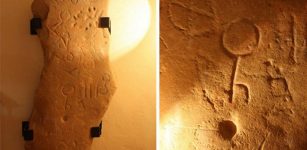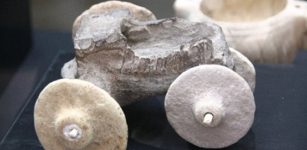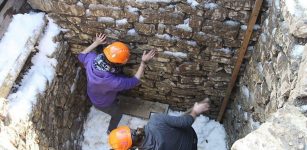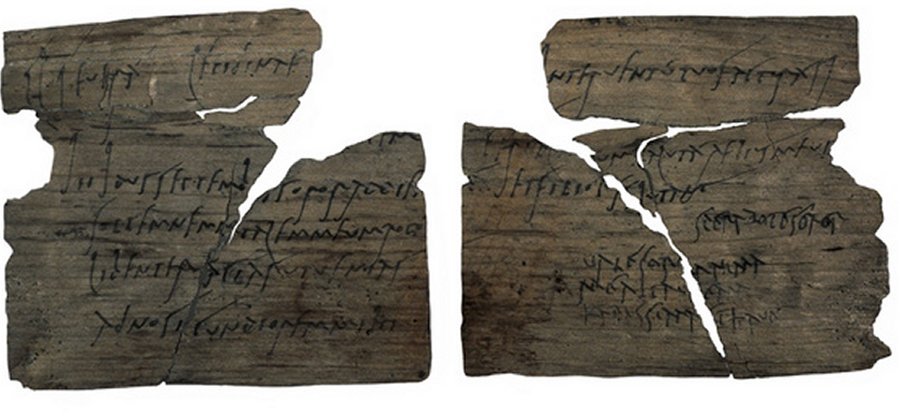Vindolanda Wooden Tablets: Ancient Military And Private Correspondence Left By Departing Roman Troops
A. Sutherland - AncientPages.com The fort of Vindolanda, one of the earliest Roman garrisons, built by the Roman army in England, is one of Europe's most important Roman archeological sites.
Vindolanda Roman fort. Image credit: Chris Gunns - CC BY-SA 2.0
It guarded the Stanegate, the Roman road from the River Tyne to the Solway Firth, and was situated behind Hadrian’s Wall, near the modern village of Bardon Mill in Northumberland, England.
It's worth mentioning that "literally the "Stone Road" was not just a road but a frontier system that predates Hadrian's Wall. The road links Corbridge to Carlisle and has a fort system that appears to repeat in a pattern of large - small - large - small, etc. The first fort in Cumbria from the east is Throp, one of the small ones. Note that a small fort at Crosby would be expected but one has not been found (yet) as wrote A Gazeteer, "The Roads Of Roman Britain",
Fort Vindolanda was originally constructed in turf and timber before Hadrian's Wall was built around 122 AD, and was repaired and rebuilt several times. Vindolanda garrison was destroyed and completely rebuilt at least nine times. Each community left its own unique features on the surrounding landscape.
To this famous Roman fort, there are related the Vindolanda Letters also known as the Vindolanda tablets, the oldest surviving, handwritten in Latin documents found in Britain. They are considered the best source of information about life on the northern frontier of Roman Britain.
Sandal was found at Vindolanda and is now on display in the Museum. Image credit: Colgill - CC BY-SA 4.0
The first post-Roman record of the ruins at Vindolanda was made by the antiquarian William Camden, in his Britannia (1586). Occasional travelers reached the site over the next two hundred years, and the accounts they left are useful because they predate much of the stone-stealing that has damaged the site.
Excavation of the fort began in 1970 and the tablets had not been recovered until 1973 when archaeologist Robin Birley unearthed them at the site of a Roman fort in Vindolanda, northern England.
Excavations yielded around 1,000 wooden writing tablets left by departing troops and well-preserved in the environment of the peat.
The texts of 752 tablets have been transcribed, translated, and published but archaeologists still find new tablets of Vindolanda. Credits: British Museum.
Most of the 752 Vindolanda letters were written during the period 92-102 AD and some of them are dated from 103 to 130 AD.
Written in ink on postcard-sized sheets of wood, due to a lack of papyrus), the longer documents were tied together by punching a hole in the corner. The writing tablets used the local woods – birch, alder, or oak taken from young trees.
The letters enable us to imagine community life and give a unique insight into the Roman official military correspondence, which demonstrated the army’s work assignments, efficiency, the soldiers’ food, and how they did spend their time off.
Many of the letters are strictly private, such as one recorded on the tablet 346, which reveals the following message:
‘I have sent you ... pairs of socks from Sattua, two pairs of sandals, and two pairs of underpants.’ It was obviously a bit cold for soldiers on the northwest frontier of the Roman Empire.
 Letter from Octavius to Candidus concerning supplies of wheat, hides, and sinews. Credits: British Museum
Letter from Octavius to Candidus concerning supplies of wheat, hides, and sinews. Credits: British Museum
In one letter (tablet 291) Claudia Severa invites her sister Sulpicia Lepidina to her birthday party held in 100 AD.
"On 11 September, sister, for the day of the celebration of my birthday, I give you a warm invitation to make sure that you come to us, to make the day more enjoyable for me by your arrival… I shall expect you, sister. Farewell, sister, my dearest soul, as I hope to prosper, and hail."
The men stationed at Vindolanda fort were Germans writing in Latin, serving the Roman army in England. Through these letters recorded on sheets of wood, these people remained connected with other soldiers and their families living across the Empire.
This impressive collection of letters includes a list of household goods, an official account of troop strength, a memorandum on the customs of the Britons, a letter of recommendation to the provincial governor, a birthday invitation from the wife of the garrison commander, and a letter from one soldier rebuking another for not writing more often.
There are also official reports, administrative accounts of the garrison, and personal letters.
Written by – A. Sutherland AncientPages.com Staff Writer
Updated on September 22, 2022
Copyright © AncientPages.com All rights reserved. This material may not be published, broadcast, rewritten or redistributed in whole or part without the express written permission of AncientPages.com
Expand for referencesMore From Ancient Pages
-
 Ancient Secrets Of The Amazon Jungle – Dangerous Expeditions And Hidden Treasures – Part 1
Ancient Mysteries | Mar 1, 2019
Ancient Secrets Of The Amazon Jungle – Dangerous Expeditions And Hidden Treasures – Part 1
Ancient Mysteries | Mar 1, 2019 -
 Legendary Mount Penglai Where The Eight Immortals Reside
Chinese Mythology | Feb 20, 2018
Legendary Mount Penglai Where The Eight Immortals Reside
Chinese Mythology | Feb 20, 2018 -
 Hidden Inca Water System Beneath The Machu Picchu Jungle Discovered By LIDAR
Archaeology | Mar 11, 2022
Hidden Inca Water System Beneath The Machu Picchu Jungle Discovered By LIDAR
Archaeology | Mar 11, 2022 -
 Tezcatlipoca: Enigmatic Aztec God Who Looked Inside People’s Hearts And Observed Their Deeds On Earth
Aztec Mythology | Jul 22, 2021
Tezcatlipoca: Enigmatic Aztec God Who Looked Inside People’s Hearts And Observed Their Deeds On Earth
Aztec Mythology | Jul 22, 2021 -
 Why Were Ba And Ka Powerful Elements Of Soul In Ancient Egyptian Beliefs?
Egyptian Mythology | Apr 21, 2020
Why Were Ba And Ka Powerful Elements Of Soul In Ancient Egyptian Beliefs?
Egyptian Mythology | Apr 21, 2020 -
 Mysterious Undeciphered Carvings And Script On Stela Of Montoro
Archaeology | Aug 14, 2017
Mysterious Undeciphered Carvings And Script On Stela Of Montoro
Archaeology | Aug 14, 2017 -
 Roman Theater Unearthed After 1,700 Years Near Western Wall In Jerusalem
Archaeology | Oct 19, 2017
Roman Theater Unearthed After 1,700 Years Near Western Wall In Jerusalem
Archaeology | Oct 19, 2017 -
 Surprising Discovery Of Almost Intact Roman Sanctuary With Temples In The Netherlands
Archaeology | Dec 23, 2022
Surprising Discovery Of Almost Intact Roman Sanctuary With Temples In The Netherlands
Archaeology | Dec 23, 2022 -
 On This Day In History: Charlemagne Became The King Of The Franks – On Dec 5, 771
News | Dec 5, 2016
On This Day In History: Charlemagne Became The King Of The Franks – On Dec 5, 771
News | Dec 5, 2016 -
 Ancient Mesoamericans Drank Tobacco In Healing Rituals – Ceramic Vases From Cotzumalhuapa, Guatemala Reveal
Archaeology | Mar 6, 2024
Ancient Mesoamericans Drank Tobacco In Healing Rituals – Ceramic Vases From Cotzumalhuapa, Guatemala Reveal
Archaeology | Mar 6, 2024 -
 Seven Gods Of Happiness – Bring Luck, Prosperity And Health In Japanese Folk Belief
Featured Stories | Jun 29, 2020
Seven Gods Of Happiness – Bring Luck, Prosperity And Health In Japanese Folk Belief
Featured Stories | Jun 29, 2020 -
 4,000-Year-Old Scottish Clava Cairns Were Built To House Dead
Civilizations | Nov 27, 2018
4,000-Year-Old Scottish Clava Cairns Were Built To House Dead
Civilizations | Nov 27, 2018 -
 On This Day In History: Isaac Asimov Creator Of Science Fiction Was Born – On Jan 2, 1920
News | Jan 2, 2017
On This Day In History: Isaac Asimov Creator Of Science Fiction Was Born – On Jan 2, 1920
News | Jan 2, 2017 -
 World’s Oldest Toy Car – Could This 7500-Year-Old Discovery Be The Earliest Evidence Of The Wheel?
Artifacts | Sep 1, 2018
World’s Oldest Toy Car – Could This 7500-Year-Old Discovery Be The Earliest Evidence Of The Wheel?
Artifacts | Sep 1, 2018 -
 Did Ancient Romans Use Four-Meter Deep Shafts As Refrigerators During Summer?
Archaeology | Apr 6, 2018
Did Ancient Romans Use Four-Meter Deep Shafts As Refrigerators During Summer?
Archaeology | Apr 6, 2018 -
 Unique discovery of unknown inscription may change the history of scripts as we know it.
News | Aug 23, 2015
Unique discovery of unknown inscription may change the history of scripts as we know it.
News | Aug 23, 2015 -
 Tomb Of Last Ruler Of A Sunken Kingdom Remains An Ancient Mystery
Ancient Mysteries | Mar 24, 2021
Tomb Of Last Ruler Of A Sunken Kingdom Remains An Ancient Mystery
Ancient Mysteries | Mar 24, 2021 -
 Mysterious Wise Pre-Flood Beings Who Gave Humans A Precious Gift – Did We Reject It?
Featured Stories | Mar 9, 2025
Mysterious Wise Pre-Flood Beings Who Gave Humans A Precious Gift – Did We Reject It?
Featured Stories | Mar 9, 2025 -
 Mysterious Ancient Danube Stone Faces And The Fish Goddess Connection
Ancient Mysteries | Dec 18, 2019
Mysterious Ancient Danube Stone Faces And The Fish Goddess Connection
Ancient Mysteries | Dec 18, 2019 -
 Roman Treasures Unearthed At Ancient Site Of Tiel, Netherlands
Archaeology | Apr 2, 2017
Roman Treasures Unearthed At Ancient Site Of Tiel, Netherlands
Archaeology | Apr 2, 2017



